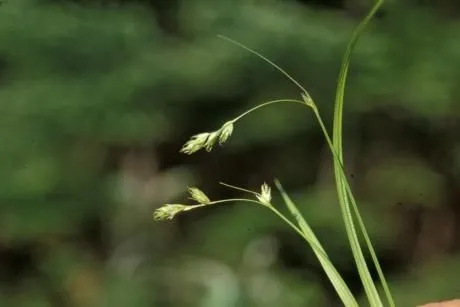
Author: Schwein.
Bibliography: Ann. Lyceum Nat. Hist. New York 1: 65 (1824)
Year: 1824
Status: accepted
Rank: species
Genus: Carex
Vegetable: False
Observations: Canada to N. & WC. U.S.A.
The Dewey sedge, scientifically known as Carex deweyana, is a notable species within the Cyperaceae family. It was first described by the renowned botanist Schweinitz, with an official documentation appearing in the Ann. Lyceum Nat. Hist. New York in the year 1824.
This perennial sedge is primarily distributed across North America, extending from Canada down to the northern and western regions of the United States. Dewey sedge thrives in these areas due to the favorable climatic and soil conditions that support its growth and development.
Characterized by its fine-textured foliage and distinctive seed heads, Carex deweyana is often found in woodland settings, flourishing in the dappled shade and moist, well-drained soils typical of these environments. The plant’s long, slender leaves form dense clumps that contribute significantly to the ground cover in forested areas, helping to prevent soil erosion and promote the stability of the forest floor.
Ecologically, Dewey sedge plays a vital role in its habitat, providing shelter and food for various wildlife species. Its seeds are a source of nourishment for birds and small mammals, while the plant itself offers cover and breeding grounds for numerous insects.
In addition to its ecological importance, Carex deweyana is also valued for its aesthetic appeal in natural landscaping projects. Its graceful, arching blades and understated elegance make it a preferable choice for gardeners aiming to create a naturalistic, low-maintenance garden design.
Overall, the Dewey sedge’s adaptability, ecological benefits, and visual appeal make it a noteworthy species within the Cyperaceae family, contributing to the biodiversity and beauty of North American woodlands.
Eng: dewey sedge, dewey’s sedge, short-scale sedge
Fra: carex de dewey
En: Dewey sedge, Dewey’s Sedge, ROUND-FRUIT SHORT-SCALE SEDGE, Short-scale sedge
Fr: Carex de Dewey
Taken May 4, 2010 by EOL − Andrew Hipp (cc-by-nc-sa)
Taken Jan 9, 2015 by EOL − podiceps (cc-by-nc)
Taken Jul 16, 2015 by EOL − benconnorbarrie (cc-by-nc)
Taken Dec 29, 2014 by EOL − podiceps (cc-by-nc)
Growth form>: Bunch
Growth habit>: Graminoid
Growth rate>: Moderate
Ph maximum: 7.0
Ph minimum: 5.4
Family: Myrtaceae Author: (F.Muell.) K.D.Hill & L.A.S.Johnson Bibliography: Telopea 6: 402 (1995) Year: 1995 Status:…
Family: Rubiaceae Author: Pierre ex A.Froehner Bibliography: Notizbl. Bot. Gart. Berlin-Dahlem 1: 237 (1897) Year:…
Family: Sapindaceae Author: Koidz. Bibliography: J. Coll. Sci. Imp. Univ. Tokyo 32(1): 38 (1911) Year:…
Family: Asteraceae Author: A.Gray Bibliography: Pacif. Railr. Rep.: 107 (1857) Year: 1857 Status: accepted Rank:…
Family: Fabaceae Author: Medik. Bibliography: Vorles. Churpfälz. Phys.-Ökon. Ges. 2: 398 (1787) Year: 1787 Status:…
Family: Aspleniaceae Author: (Cav.) Alston Bibliography: Bull. Misc. Inform. Kew 1932: 309 (1932) Year: 1932…